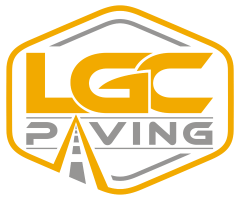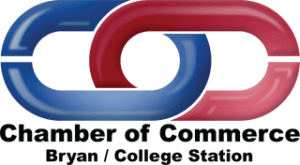Concrete Parking Lot Repair College Station: Your Guide to Durable Solutions
Maintaining a well-kept parking lot is vital for any business or property owner, especially in College Station where the appearance and functionality of commercial and public spaces are highly regarded. A concrete parking lot is no exception to the wear and tear of daily use, and over time, it will inevitably require repairs. Damage can manifest in the form of cracks, potholes, and uneven surfaces, posing not only aesthetic issues but also safety risks to vehicles and pedestrians. It is essential to assess these damages promptly and thoroughly to determine the best course of action for repair.
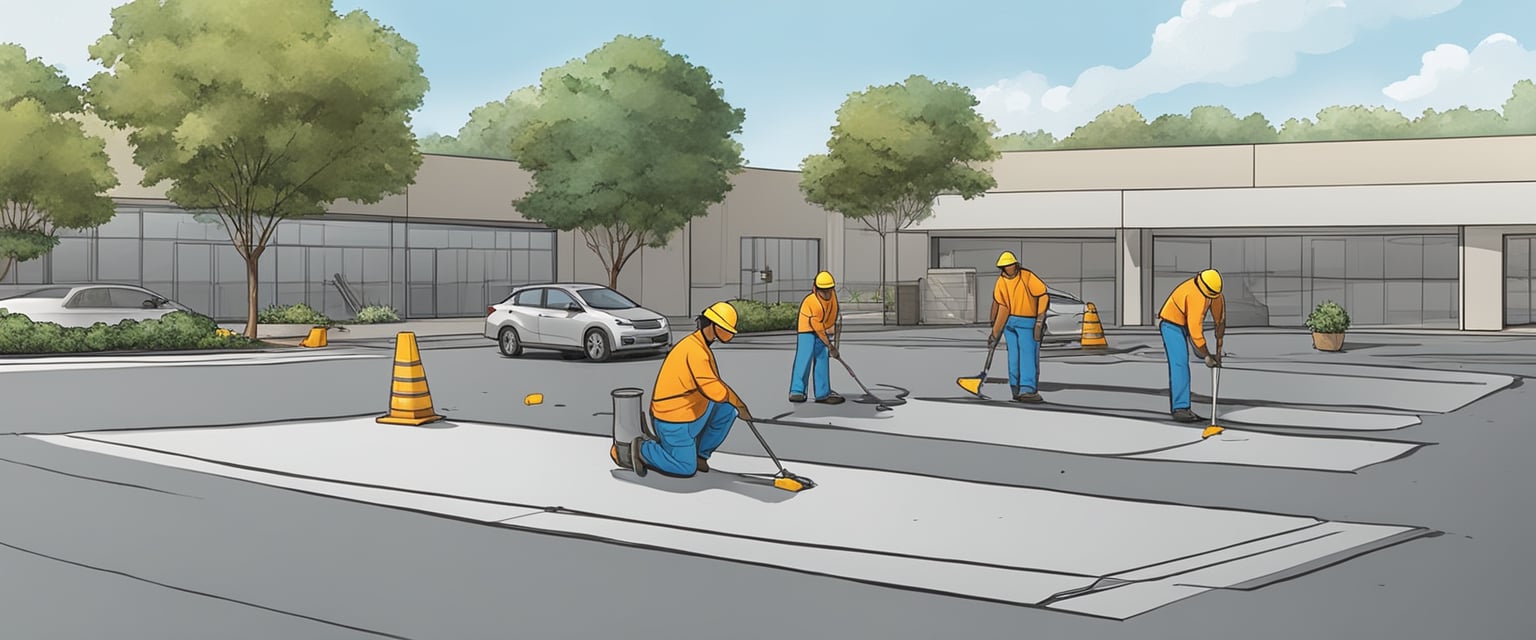
When it comes to repairing concrete parking lots, several steps must be taken to ensure durability and longevity. The process generally involves cleaning the damaged areas, removing any unstable concrete, and then filling the voids with repair materials that are designed to bond with the existing concrete. For substantial repairs, professional services are often required to achieve optimal results. These professionals are equipped with the knowledge and tools to perform the repairs efficiently and effectively, adhering to the latest safety standards and local regulations. They can also provide invaluable guidance on maintenance strategies to prevent future damage and extend the lifespan of the parking lot.
Key Takeaways
- Concrete parking lot repair in College Station is crucial for safety and aesthetics.
- The repair process involves assessment, removal of damaged areas, and application of specialized materials.
- Professional repair services offer efficiency, compliance with safety standards, and maintenance advice.
Assessing Damage to Concrete Parking Lots
When examining concrete parking lots for damage, it’s important to focus on common signs of deterioration that can undermine the lot’s structural integrity and safety. Specialists often start by searching for visible cracks, which are typically the most common form of damage. These fissures can range from fine hairlines to larger gaps, and they usually warrant further investigation to determine their cause and the extent of underlying issues.
Damage can also present as potholes or surface spalling, the latter being a condition where the concrete flakes or chips away, often due to rebar corrosion or freeze-thaw cycles. Another aspect of damage assessment includes checking for signs of frost heaves, which occur when water in the ground freezes and expands, pushing the concrete upward and creating an uneven surface.
To accurately assess the condition, it’s vital to conduct regular inspections, as early detection is crucial for cost-effective repairs. Experts suggest looking for patterns of damage that could indicate problems with the subgrade or issues with water drainage, which often necessitate more significant repair strategies.
Professionals use a range of tools and techniques to assess concrete parking lot damage, taking into account:
- Size and extent: Measuring cracks and spalling areas for width and depth.
- Location: Identifying whether the damage is isolated or widespread.
- Drainage: Evaluating how well the parking lot sheds water to identify potential water damage.
Once the damage is assessed, specialists can determine the appropriate repair solutions for lasting results.
Materials Needed for Concrete Parking Lot Repair
The repair of a concrete parking lot requires specific materials to ensure the longevity and durability of the pavement. Each type of material plays a critical role in the restoration process.
Concrete Mix Selection
Selecting the appropriate concrete mix is vital for the repair process. Typically, a high-strength concrete mix with a proper aggregate size is used to withstand vehicular loads and environmental stress. Depending on the damage, one might use:
- Patch repair compounds: For shallow repairs.
- Polymer-modified concrete: Used for areas with medium-depth damage.
Reinforcement Materials
Proper reinforcement is essential for preventing future damage. Reinforcement materials might include:
- Steel rebar or wire mesh: Provides structural support.
- Fiberglass or synthetic fibers: Enhance concrete’s tensile strength and reduce the chance of cracking.
Sealing and Finishing Products
To protect the repaired area and extend the life of the parking lot, sealing and finishing products are applied. They might include:
- Epoxy sealants: These fill and bond cracks effectively.
- Curing compounds: They help maintain adequate moisture during the concrete’s curing phase.
Use of these materials ensures a smooth and resilient parking lot surface after repairs.
Concrete Parking Lot Repair Procedures
The repair of concrete parking lots in College Station involves specific steps to ensure longevity and safety of the surface. These procedures are generally best left to experienced professionals due to the technical nature of the tasks.
Surface Cleaning
Before any repairs commence, it’s critical that the concrete surface is thoroughly cleaned. This involves removing all debris, dirt, and loose concrete particles. Professionals often employ power washing or industrial sweeping to ensure the surface is suitably prepared for the subsequent repair processes.
Crack Filling and Patching
For cracks that have appeared in the concrete, they must be filled and patched to prevent further damage. The process usually involves:
- Routing out the crack to create a uniform space.
- Filling the crack with a suitable concrete repair material such as a sealant or epoxy-based filler.
- Smoothing out the patch to blend with existing concrete.
Pothole Repair
Potholes pose significant trip hazards and can cause vehicle damage. Repairing them involves:
- Excavating the area around the pothole to remove all weak material.
- Applying a concrete mix specifically designed for pothole repair.
- Tamping down the repair material to ensure a dense and even fill.
- Finishing the surface to match the level and texture of the surrounding pavement.
Best Practices in Concrete Parking Lot Maintenance

Proper maintenance ensures longevity and safety for concrete parking lots. Adhering to a strategic plan can prevent costly repairs and prolong the pavement’s service life.
Regular Inspection
Regular inspections are critical in spotting early signs of wear and damage. Property managers should conduct these inspections biannually, scrutinizing the surface for cracks, potholes, and signs of wear. Attention to detail during inspections can facilitate timely repairs that mitigate more severe deterioration.
Preventive Measures
Implementing proactive steps can significantly reduce future repair needs. Key preventive measures include the application of sealants, prompt removal of oil stains, and maintenance of proper drainage systems to prevent water accumulation. These actions help preserve the structural integrity of concrete parking lots and protect against environmental and traffic-induced stresses.
Cleaning and Sealing Regimen
A consistent routine of cleaning and sealing preserves a parking lot’s aesthetic and functional qualities. Experts recommend power washing the surface annually to remove dirt and grime, followed by applying a high-quality sealer. Sealers should be reapplied every 1-2 years, depending on lot usage and weather conditions.
By focusing on regular inspection, preventive measures, and a stringent cleaning and sealing regimen, concrete parking lots can maintain optimal condition, ensuring durability and safety for users.
Safety Considerations for Repair Work
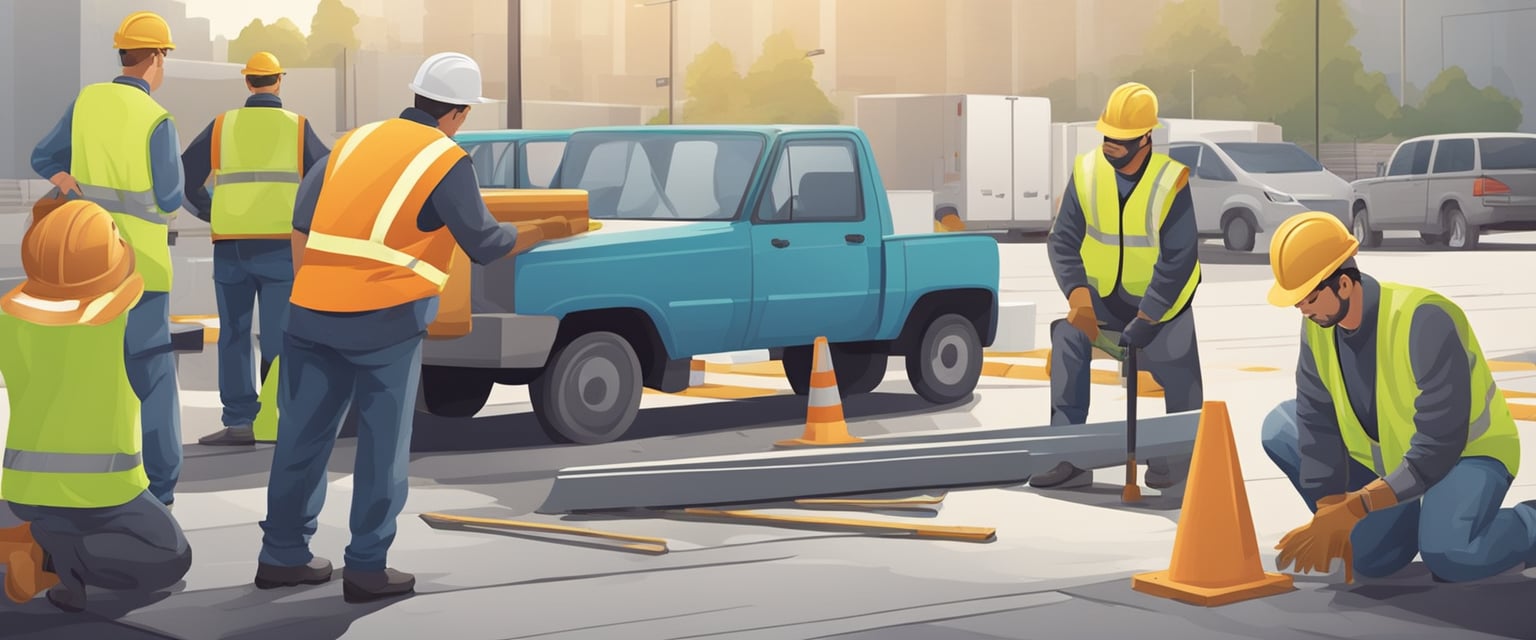
When undertaking concrete parking lot repair, prioritizing safety is non-negotiable. It involves managing onsite traffic, safely handling equipment, and ensuring the use of personal protective gear.
Traffic Management
During repair, it is crucial to establish clear traffic rerouting plans to prevent accidents and ensure the safety of both workers and pedestrians. Signage and barriers should be employed to direct vehicles away from construction zones.
Equipment Handling
The use of heavy machinery is inherent in parking lot repairs. Operators must be certified and trained, and all equipment should undergo regular maintenance checks to minimize the risk of malfunctions and accidents.
Personal Protective Equipment
Workers must be provided with and required to use personal protective equipment (PPE), such as safety helmets, goggles, high-visibility clothing, and steel-toed boots. Proper PPE helps prevent injuries from on-site hazards.
Hiring Professional Repair Services
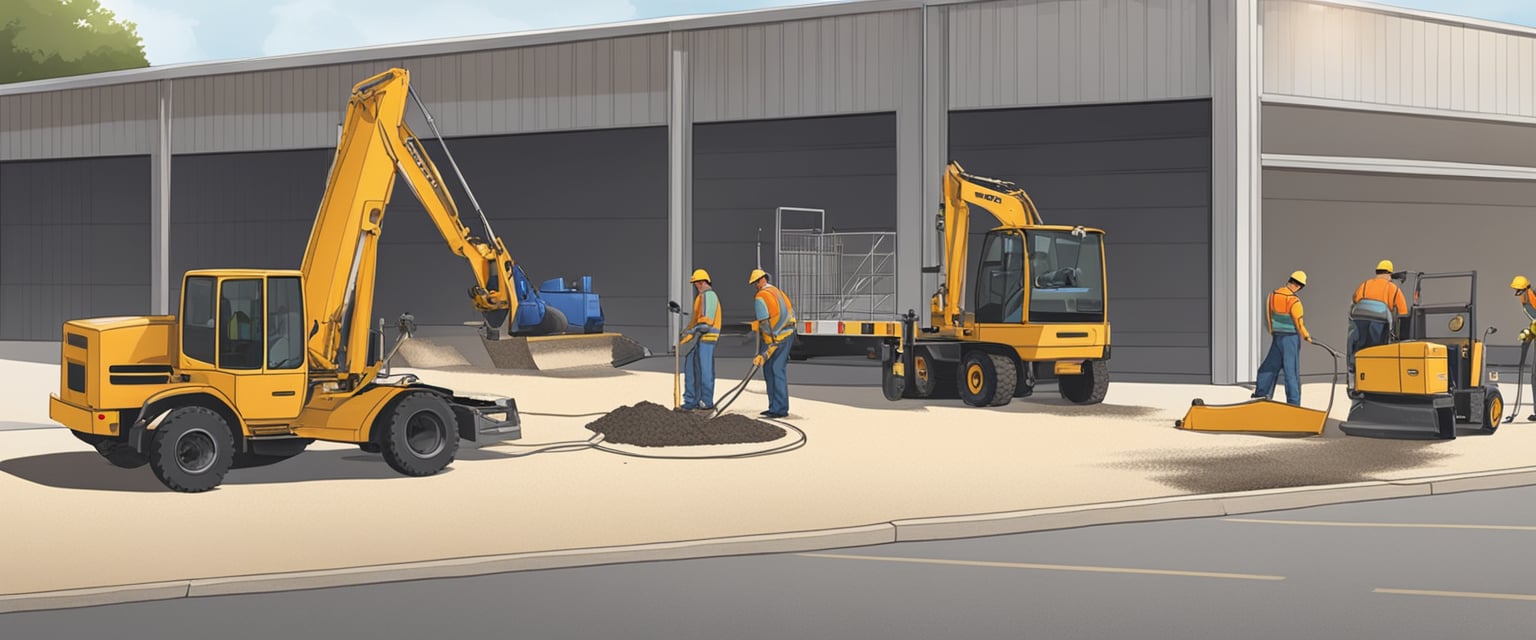
When it comes to repairing a concrete parking lot in College Station, selecting the right contractor is critical. This ensures longevity and quality of work. The reader should focus on specific criteria to evaluate potential contractors and understand the nuances of repair contracts before committing.
Criteria for Contractor Selection
The selection of a contractor should be based on specific qualifications and proven expertise. Essential criteria include:
- Licensing: They must be fully licensed in Texas to perform concrete repair.
- Experience: A minimum of several years specializing in concrete repair can suggest a reliable track record.
- Local Reviews: Testimonials from clients in College Station provide real-world proof of quality.
- Portfolio: A gallery of completed jobs, can demonstrate a contractor’s capabilities.
- Insurance: Proper insurance protects against any potential liability.
A contractor should meet all of these benchmarks before consideration for your project.
Understanding Repair Contracts
A repair contract details the scope, duration, costs, and terms of service. When engaging with a contractor,a few important contract aspects include:
- Scope of Work: A clear and concise description of all repair work, including materials and techniques used.
- Payment Schedule: Defined payment milestones tied to specific project phases.
- Warranty: Clauses that specifically outline what is covered post-repair should issues arise.
- Timeline: Realistic start and completion dates with allowances for weather-related delays.
It’s crucial that both parties have a mutual understanding of every detail within the contract.
Cost Estimation and Budget Planning
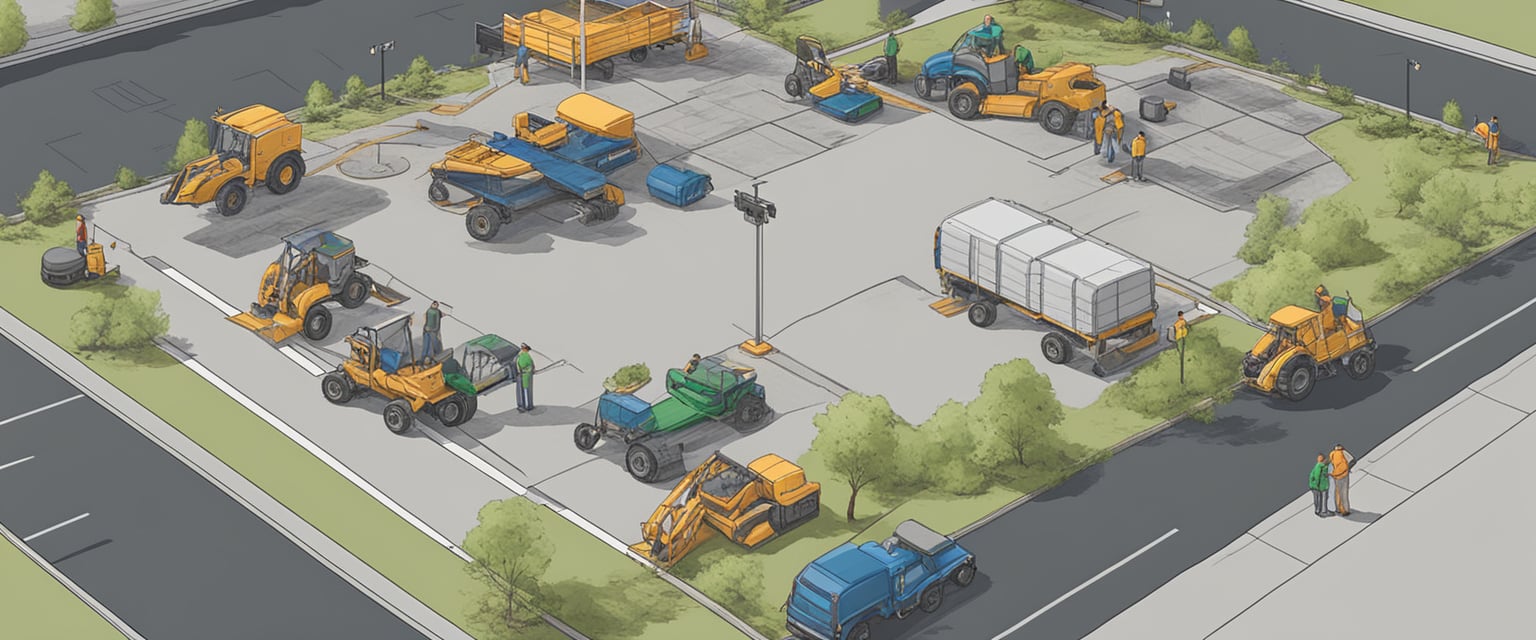
When estimating the cost for repairing a concrete parking lot in College Station, one needs to consider several factors that will impact the budget. This section explores the essential components for budget planning and cost estimation.
Firstly, the area of repair is crucial; costs are generally calculated per square foot. The total expenditure can be estimated by multiplying this rate by the square footage of the damaged area.
Typical Cost Factors:
- Material Costs: Concrete prices can vary, but an average cost is $5.50 per square foot.
- Labor: Installation and repair work.
- Maintenance: Future costs for upkeep should be accounted for, which typically amount to around 80% of the initial installation costs.
Sample Calculation:
Area (sq ft) – 1000
Cost Per Sq Ft ($) – 5.50
Total Cost ($) – 5500
Moreover, it is advisable to inquire about estimates from qualified contractors to ensure accuracy and consider any variables specific to a given site.
To avoid unexpected expenses, one should also include a buffer, approximately 10-20% of the total estimated cost, to cover unforeseen issues that may arise during the repair process.
In summary, effective budget planning for concrete parking lot repairs requires a solid understanding of the current rates, the area needing repair, and additional maintenance expenses. By diligently assessing these factors, one can confidently allocate a budget that reflects the true scope of the project.
Sustainability in Concrete Repairs
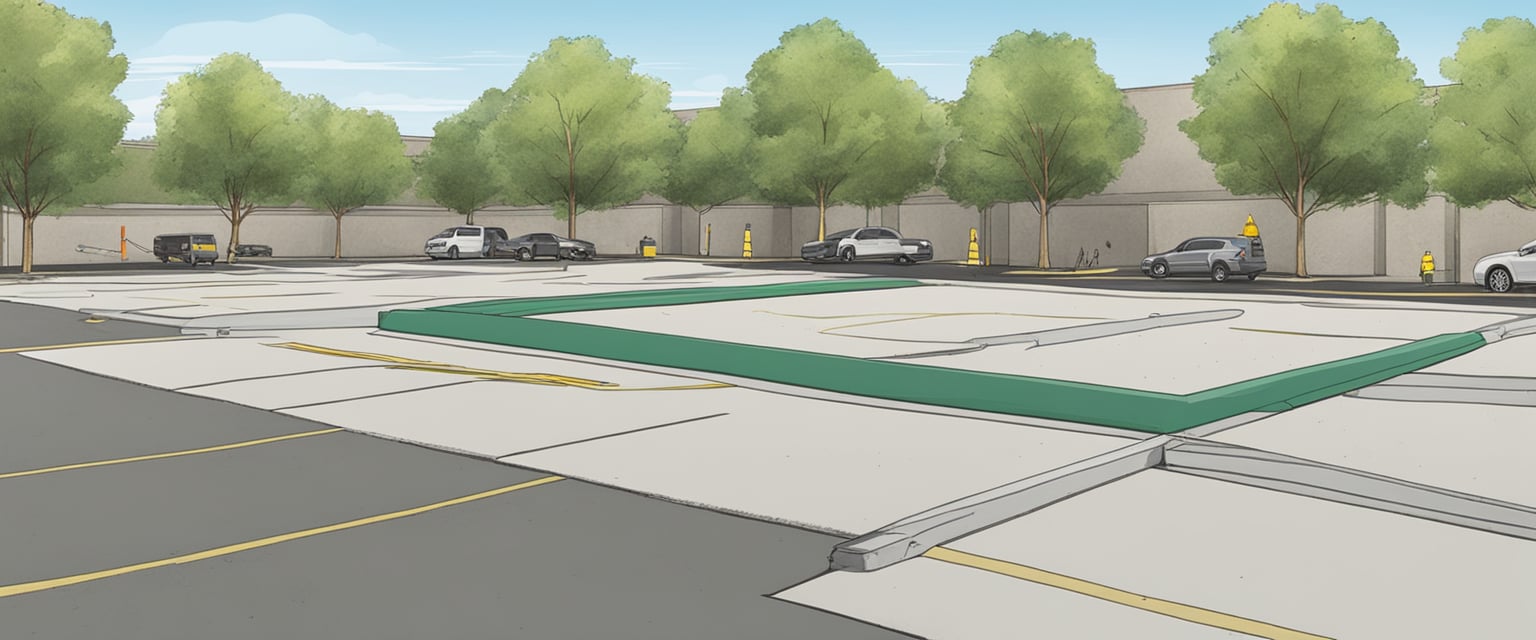
Sustainability in concrete repairs focuses on reducing the environmental footprint while maintaining structural integrity. This is achieved through the use of eco-friendly materials and innovative repair techniques.
Eco-Friendly Materials
Low-Carbon Concrete: Manufacturers are producing low-carbon concrete by reducing the amount of Portland cement, which significantly lowers the greenhouse gas emissions associated with traditional concrete production.
Recycled Aggregate: The use of recycled aggregate — sourced from demolished concrete structures — not only prevents landfill waste but also requires less energy compared to mining and processing new materials.
Repair Techniques for Reduced Environmental Impact
Partial-Depth Repair: When feasible, repairing only the deteriorated section of concrete reduces material waste. This method conserves resources by preserving intact concrete and focusing on targeted areas.
Prolonged Lifecycle Strategies: Repair techniques that extend the life of existing concrete structures minimize the need for frequent repairs. These encompass proper jointing, adequate concrete cover, and attention to curing practices, all of which help to delay deterioration and reduce long-term environmental impact.
Legal and Compliance Issues
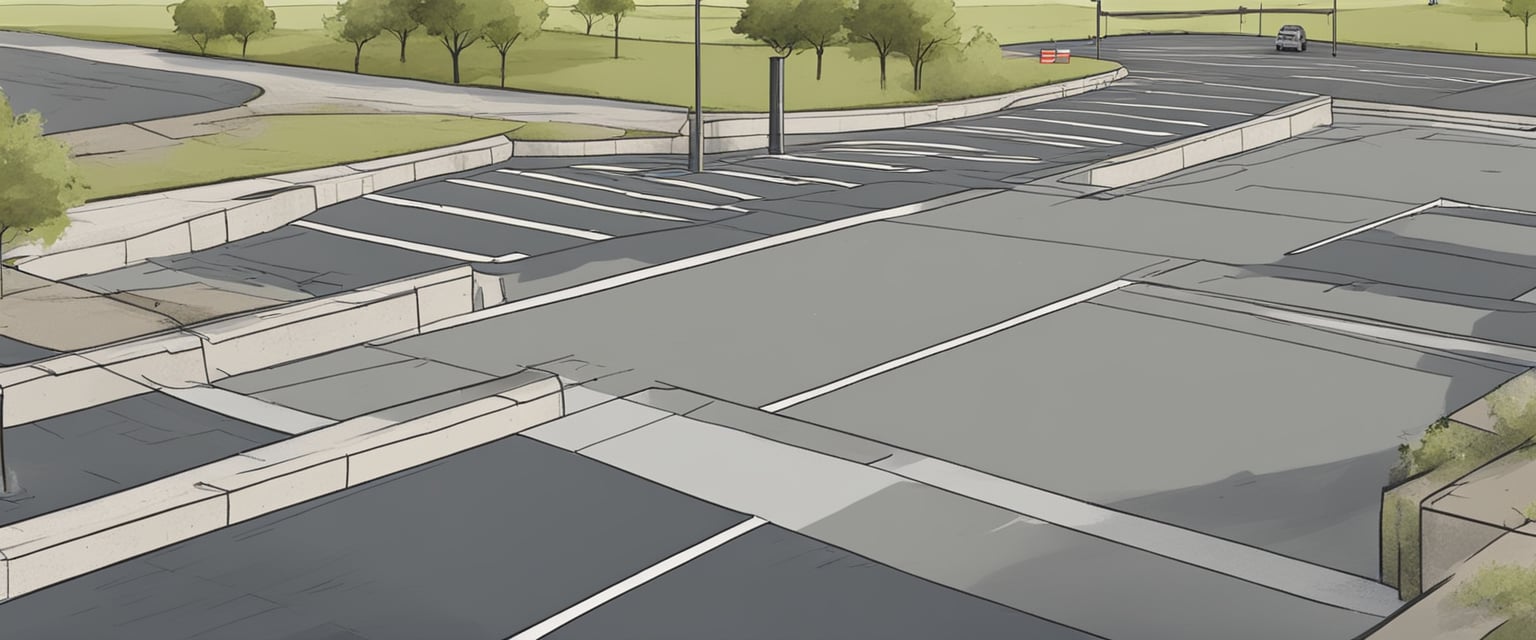
In College Station, Texas, adherence to specific local regulations is mandatory for concrete parking lot repair. It’s imperative that contractors and property owners are familiar with the latest Building Codes and understand the process for Permits and Inspections to avoid possible legal complications.
Building Codes
In College Station, the repair of concrete parking lots must comply with the local Unified Development Ordinance. This includes adherence to standards for construction materials and methods. For example, the Code of Ordinances in College Station stipulates that surfaces must withstand the local environmental conditions.
Permits and Inspections
Before initiating any parking lot repairs, securing the required permits is crucial. The City of College Station requires that inspections be conducted post-repair to ensure compliance with established ordinances. Without the proper permits, repair work can be halted, and substantial fines may be levied.
Frequently Asked Questions

When approaching the maintenance of a concrete parking lot, informed decision-making can save both time and money. The following frequently asked questions provide clear, straightforward guidance.
How much does it typically cost to repair a concrete parking lot?
Repairing a concrete parking lot can vary in cost depending on the extent of the damage and location. Simple repairs like filling cracks may be relatively inexpensive, while more extensive rehabilitation or complete resurfacing will entail a higher cost.
What are the best methods for repairing cracks in a concrete parking lot?
The best methods for repairing cracks include cleaning out the crack, filling it with a concrete crack filler or sealant, and ensuring the area is properly cured to prevent further damage.
What steps are involved in repairing a broken concrete driveway?
Repairing a broken concrete driveway involves removing the damaged sections, re-establishing a stable sub-base, pouring new concrete, and curing it correctly to ensure a durable surface.
Can a concrete parking lot be repaired or does it need to be replaced?
Whether a concrete parking lot can be repaired or needs to be replaced depends on the severity of the damage. Minor issues like small cracks can often be repaired, while significant damage such as widespread cracking or foundation issues may necessitate replacement.
What are the signs that a concrete parking lot needs repairs?
Signs that a parking lot needs repairs include potholes, large cracks, uneven surfaces, and water pooling. These conditions can compromise the integrity of the parking lot and should be addressed promptly.
How long does a typical concrete parking lot repair take to complete?
The duration of a concrete parking lot repair depends on the scope of the work required. Small repairs might be completed in a day, whereas larger repairs requiring curing of new concrete can take several days to weeks.
